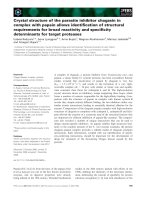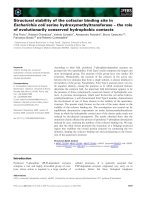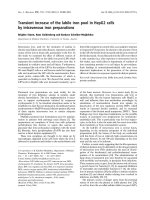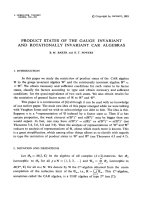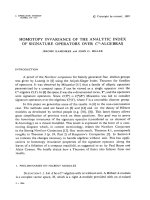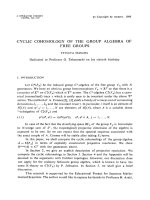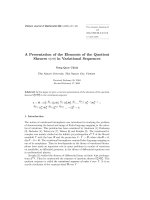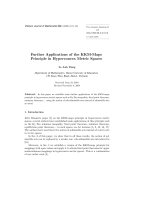Báo cáo toán học: "Lower Semicontinuity of the KKT Point Set in Quadratic Programs Under Linear Perturbations" ppt
Bạn đang xem bản rút gọn của tài liệu. Xem và tải ngay bản đầy đủ của tài liệu tại đây (158.36 KB, 12 trang )
Vietnam Journal of Mathematics 34:4 (2006) 411–422
Lower Semicontinuity of the KKT Point
Set in Quadratic Programs Under
Linear Perturbations
*
G. M. Lee
1
,N.N.Tam
2
,andN.D.Yen
3
1
Department of Applied Math., Pukyong National University, Busan, Korea
2
Department of Math., Hanoi Pedagogical Institute No.2,
Xuan Hoa, Me Linh, Vinh Phuc, Vietnam
3
Institute of Mathematics, 18 Hoang Quoc Viet Road, 10307 Hanoi, Vietnam
Dedicated to Professor Do Long Van on the occasion of his 65
th
birthday
Received April 17, 2006
Abstract. We establish necessary and sufficient conditions for the lower semicontinu-
ity of the Karush-Kuhn-Tucker point set in indefinite quadratic programs under linear
perturbations. The obtained results are illustrated by examples.
2000 Mathematics Subject Classification: 90C20, 90C26, 90C31.
Keywords: Indefinite quadratic program, linear perturbation, KKT point set, lower
semicontinuity.
1. Introduction
The problem of minimizing or maximizing a linear-quadratic function on a con-
vex polyhedral set is called a quadratic program. Since the appearance of the
paper by Daniel [4] in 1973, continuity and differentiability properties of the so-
lution map, the local solution map, the Karush-Kuhn-Tucker (KKT, for brevity)
point set mapping and the optimal value function in parametric quadratic pro-
gramming have been studied intensively in the literature. In particular, upper
∗
This work was supported in part by the Korea Research Foundation and the Korea Science
and Engineering Foundation.
412 G. M. Lee, N. N. Tam, and N. D. Yen
semicontinuity and also lower semicontinuity of the KKT point set mapping in
indefinite quadratic programs under perturbations were investigated in [11 - 13]
where it was assumed that every component of the data is subject to perturba-
tion. If only the linear part of the data is subject to perturbation, then the upper
semicontinuity of the KKT point set mapping can be studied via a theorem of
Robinson [9] on the upper Lipschitz continuity of polyhedral multifunctions.
The aim of this paper is to derive necessary and sufficient conditions for the
lower semicontinuity of the Karush-Kuhn-Tucker point set in indefinite quadratic
programs under linear perturbations. The necessary conditions are relatively
simple. But the sufficient conditions are rather sophisticated. A series of exam-
ples is designed to show how each set of the sufficient conditions can be realized
in practice.
We consider the quadratic program
Minimize f(x):=
1
2
x
T
Dx + c
T
x subject to x ∈ Δ(A, b), (1)
where Δ(A, b)={x ∈ R
n
: Ax ≥ b}, D is a symmetric (n × n)−matrix, A
is an (m × n)−matrix, b ∈ R
m
and c ∈ R
n
are some given vectors. Here the
superscript
T
denotes transposition. In what follows, matrices D and A will be
fixed, while vectors c and b are subject to change. Since D is not assumed to be
a positive semidefinite matrix, the function f is not necessarily convex. Thus we
will have deal with indefinite quadratic programs under linear perturbations.
We say that x ∈ R
n
is a Karush–Kuhn–Tucker point of (1) if there exists a
Lagrange multiplier λ ∈ R
m
corresponding to x,thatis
Dx − A
T
λ + c =0,Ax≥ b, λ ≥ 0,λ
T
(Ax − b)=0. (2)
The KKT point set of (1) is denoted by S(c, b). The solution set and the local
solution set of (1) are denoted, respectively, by Sol(c, b)andloc(c, b). It is well-
known (see [3, p. 115]) that S(c, b) ⊃ loc(c, b) ⊃ Sol(c, b). We are interested in
studying the lower semicontinuity of the multifunction
S(·):R
n
× R
m
→ 2
R
n
, (c
,b
) → S(c
,b
).
Note that lower semicontinuity properties of the multifunctions Sol(·)andloc(·),
have been studied in [5] and [7].
Recall [14, p. 451] that a multifunction F : R
k
→ 2
R
n
is said to be lower
semicontinuous (l.s.c.) at ω ∈ R
k
if F (ω) = ∅ and, for each open set V ⊂ R
n
satisfying F (ω) ∩ V = ∅,thereexistsδ>0 such that F (ω
) ∩ V = ∅ for every
ω
∈ R
k
with the property that ω
− ω <δ. This definition differs slightly
from the corresponding one given in [1, p. 39], where only the points from the
effective domain of F are taken into account.
We obtain the necessary and sufficient conditions for the lower semicontinuity
of the multifunction S(·), our main results, in Sec. 2. Then, in Sec. 3, we consider
several illustrative examples.
Throughout this paper, the scalar product and the norm in an Euclidean
space R
k
are denoted by , and ·, respectively. In matrix computations,
vectors in R
k
are understood as columns of real numbers. In the usual text
they are written as rows of real numbers. For two vectors x =(x
1
, ,x
k
),y=
Lower Semic ontinuity of the KKT Point Set 413
(y
1
, ,y
k
) ∈ R
k
, the inequality x ≥ y (resp., x>y)meansx
i
≥ y
i
(resp.,
x
i
>y
i
) for all i =1, ,k. For a matrix A ∈ R
m×n
, A
i
denotes the i−th
row of A. For a subset I ⊂{1, ,m}, A
I
is the matrix composed by the
rows A
i
(i ∈ I)ofA. For a vector x =(x
1
, ,x
k
) ∈ R
k
andanindexset
J ⊂{1, ,k}, x
J
is the vector with the components x
j
(j ∈ J). The norm in
the product space R
n
× R
m
is defined by setting (c, b) =(c
2
+ b
2
)
1/2
for
every (c, b) ∈ R
n
× R
m
.
2. Main Results
Necessary and sufficient conditions for the lower semicontinuity of the multifunc-
tion S(·) will be established in this section. Recall that the inequality system
Ax ≥ b is said to be regular if the Slater condition is satisfied, i.e., there exists
¯x ∈ R
n
such that A¯x>b. It is easily seen that if the system Ax ≥ b is irregular
then there exists a sequence {b
k
}⊂R
m
converging to b such that, for each k,
the system Ax ≥ b
k
has no solutions.
Theorem 2.1 (Necessary conditions for lower semicontinuity). If the multifunc-
tion S(·) is lower semicontinuous at (c, b), then the system Ax ≥ b is regular
and the set S(c, b) is nonempty and finite.
Proof. Suppose that S(· ) is l.s.c. at (c, b). By definition, S(c, b) = ∅.Ifthe
system Ax ≥ b is irregular, then there exists a sequence {b
k
}⊂R
m
converging
to b such that Δ(A, b
k
)=∅ for all k ∈ N . ThisimpliesthatS(c, b
k
)=∅ for all
k ∈ N.ThenS(·) cannot be l.s.c. at (c, b), a contradiction.
In order to prove that S(c, b) is a finite set, for each subset I ⊂{1, ···,m}
we define a matrix M
I
∈ R
(n+|I|)×(n+|I|)
,where|I| is the number of elements of
I, by setting
M
I
=
D −A
T
I
A
I
O
(If I = ∅, then we put M
I
= D). Let
Q
I
=
(u, v) ∈ R
n
× R
m
:
u
v
I
= M
I
x
λ
I
for some (x, λ) ∈ R
n
× R
m
,
and
Q =
{Q
I
: I ⊂{1, ···,m}, det M
I
=0} .
If det M
I
=0,thenQ
I
is a proper linear subspace of R
n
× R
m
.Bythe
Baire Lemma, Q is nowhere dense in R
n
× R
m
. Hence there exists a sequence
{(c
k
,b
k
)}⊂R
n
× R
m
converging to (c, b) such that (−c
k
,b
k
) /∈ Q for all k.Fix
any ¯x ∈ S(c, b). Since S(·) is l.s.c at (c, b), without loss of generality we can as-
sume that there is a sequence {x
k
}⊂R
n
converging to ¯x such that x
k
∈ S(c
k
,b
k
)
for all k.Thenforeachk ∈ N there exists λ
k
∈ R
m
such that
⎧
⎪
⎨
⎪
⎩
Dx
k
− A
T
λ
k
+ c
k
=0,
Ax
k
≥ b
k
,λ
k
≥ 0,
(λ
k
)
T
(Ax
k
− b
k
)=0.
414 G. M. Lee, N. N. Tam, and N. D. Yen
For every k,letI
k
:= {i ∈{1, ,m} : λ
k
i
> 0}.(ItmayhappenthatI
k
= ∅.)
Clearly, there exists a subset I ⊂{1, ···,m} such that I
k
= I for infinitely many
k. Without loss of generality we can assume that I
k
= I for all k.Thenwehave
Dx
k
− A
T
I
λ
k
I
+ c
k
=0,A
I
x
k
= b
k
I
,
or, equivalently,
M
I
x
k
λ
k
I
=
−c
k
b
k
I
.
We claim that det M
I
= 0. Indeed, if det M
I
= 0 then by the definitions of Q
I
and Q we have
(−c
k
,b
k
) ∈ Q
I
⊂ Q,
contrary to the fact that (−c
k
,b
k
) /∈ Q for all k. WehaveprovedthatdetM
I
=
0. So
x
k
λ
k
I
= M
−1
I
−c
k
b
k
I
.
Letting k →∞,weget
lim
k→∞
x
k
λ
k
I
= M
−1
I
−c
b
I
.
(If I = ∅ then the last formula becomes lim
k→∞
x
k
= D
−1
(−c).)Itfollowsthat
the sequence {λ
k
I
} converges to some λ
I
≥ 0inR
|I|
. Since the sequence {x
k
}
converges to ¯x,wehave
¯x
λ
I
= M
−1
I
−c
b
I
.
Set
Z =
(x, λ) ∈ R
n
× R
m
: ∃J ⊂{1, ···,m} such that
det M
J
=0and
x
λ
J
= M
−1
J
−c
b
J
.
Let
X =
x ∈ R
n
: ∃λ ∈ R
m
such that (x, λ) ∈ Z
.
It is clear that ¯x ∈ X. From the definitions of Z and X it follows that X is a
finite set. Since ¯x ∈ X for every ¯x ∈ S(c, b), we conclude that S(c, b) is a finite
set. The proof is complete.
Example 3.1 in the next section shows that the regularity of the system
Ax ≥ b, the nonemptiness and finiteness of S(c, b), altogether, do not imply that
S(·) is l.s.c. at (c, b).
Our next goal is to find sufficient conditions for the lower semicontinuity
of the KKT point set mapping (c
,b
) → S(c
,b
)atthegivenpoint(c, b) ∈
R
n
× R
m
.
Lower Semic ontinuity of the KKT Point Set 415
Let x ∈ S(c, b)andletλ ∈ R
m
be a Lagrange multiplier corresponding to x.
We set I = {1, 2, ,m},
K = {i ∈ I : A
i
x = b
i
,λ
i
> 0},J= {i ∈ I : A
i
x = b
i
,λ
i
=0}. (3)
It is clear that K and J are two disjoint sets (possibly empty).
Theorem 2.2. (Sufficient conditions for lower semicontinuity). Suppose that
the system Ax ≥ b is regular, the set S(c, b) is finite and nonempty. If for every
x ∈ S(c, b) there exists a Lagrange multiplier λ corresponding to x such that at
least one of the following conditions holds:
(c1) x ∈ loc(c, b),
(c2) K = ∅,
(c3) J = ∅,K= ∅, and the system {A
i
: i ∈ K} is linearly independent,
(c4) J = ∅,K= ∅, D is nonsingular, and A
J
D
−1
A
T
J
is a positive definite
matrix,
where K and J are defined via (x, λ) by (3). Then, the multifunction S(·) is
lower semicontinuous at (c, b).
Proof. Since S(c, b) is nonempty, in order to prove that S(· ) is l.s.c. at (c, b)we
only need to show that, for any x ∈ S(c, b) and for any open neighborhood V
x
of x,thereexistsδ>0 such that
S(c
,b
) ∩ V
x
= ∅ (4)
for every (c
,b
) ∈ R
n
× R
m
satisfying (c
,b
) − (c, b) <δ.
Let x ∈ S(c, b)andletV
x
be an open neighborhood of x. By our assumptions,
there exists a Lagrange multiplier λ corresponding to x such that at least one of
the four conditions (c1)–(c4) holds.
We first examine the case where (c1) holds, that is x ∈ loc(c, b). Since S(c, b)
is finite, loc(c, b) is finite. So x is an isolated local solution of (1). It can be
shown that the second-order sufficient condition [10, Def. 2.1] holds at (x, λ).
Since the system Ax ≥ b is regular, we can apply Theorem 3.1 from [10] to find
a δ>0 such that
loc(D, A, c
,b
) ∩ V
x
= ∅
for every (c
,b
) ∈ R
n
× R
n
with (c
,b
) − (c, b) <δ. Since loc(c, b) ⊂ S(c
,b
),
we conclude that (4) is valid for every (c
,b
) satisfying (c
,b
) − (c, b) <δ.
Consider the case where (c2) holds, that is A
i
x>b
i
for every i ∈ I.Since
λ is a Lagrange multiplier corresponding to x, system (2) is satisfied. Because
Ax > b, from (2) we deduce that λ = 0. Then the first equality in (2) implies
that Dx = −c.Thusx is a solution of the linear system
Dz = −c (z ∈ R
n
). (5)
Since S(c, b) is finite, x is a locally unique KKT point of (1). Combining this
with the fact that x is an interior point of Δ(A, b), we can assert that x is a
unique solution of (5). Hence the matrix D is nonsingular and we have
x = −D
−1
c. (6)
416 G. M. Lee, N. N. Tam, and N. D. Yen
Since Ax > b,thereexistδ
1
> 0 and an open neighborhood U
x
⊂ V
x
of x
such that U
x
⊂ Δ(A, b
) for all b
∈ R
m
satisfying b
− b <δ
1
. By (6), there
exists δ
2
> 0 such that if c
− c <δ
2
and x
= −D
−1
c
then x
∈ U
x
.
Set δ =min{δ
1
,δ
2
}.Let(c
,b
) be such that (c
,b
) − (c, b) <δ.Since
x
:= −D
−1
c
belongs to the open set U
x
⊂ Δ(A, b
), we deduce that
Dx
+ c
=0,Ax
>b
.
From this it follows that x
∈ S(c
,b
). (Observe that λ
= 0 is a Lagrange
multiplier corresponding to x
.) We have thus shown that (4) is valid for every
(c
,b
) ∈ R
n
× R
m
satisfying (c
,b
) − (c, b) <δ.
We now suppose that (c3) holds. First, we prove that the matrix M
K
∈
R
(n+|K|)×(n+|K|)
defined by setting
M
K
=
D −A
T
K
A
K
0
,
where |K| denotes the number of elements in K, is nonsingular. To obtain a
contradiction, suppose that M
K
is singular. Then there exists a nonzero vector
(v, w) ∈ R
n
× R
|K|
such that
M
K
v
w
=
D −A
T
K
A
K
0
v
w
=0.
This implies that
Dv − A
T
K
w =0,A
K
v =0. (7)
Since the system {A
i
: i ∈ K} is linearly independent by (c3), from (7) it follows
that v = 0. Because A
I\K
x>b
I\K
and λ
K
> 0, there exists δ
3
> 0 such that
A
I\K
(x + tv) ≥ b
I\K
and λ
K
+ tw ≥ 0 for every t ∈ [0,δ
3
]. By (2) and (7), we
have
⎧
⎪
⎨
⎪
⎩
D(x + tv) − A
T
K
(λ
K
+ tw)+c =0,
A
K
(x + tv)=b
K
,λ
K
+ tw ≥ 0,
A
I\K
(x + tv) ≥ b
I\K
,λ
I\K
=0
(8)
for every t ∈ [0,δ
3
]. From (8) we deduce that x + tv ∈ S(c, b) for all t ∈ [0,δ
3
].
This contradicts the assumption that S(c, b) is finite. We have thus proved that
M
K
is nonsingular. From (2) and the definition of K it follows that
⎧
⎪
⎨
⎪
⎩
Dx − A
T
K
λ
K
+ c =0,
A
K
x = b
K
,λ
K
> 0,
A
I\K
x>b
I\K
,λ
I\K
=0.
The last system can be rewritten equivalently as follows
M
K
x
λ
K
=
−c
b
K
,λ
K
> 0,λ
I\K
=0,A
I\K
x>b
I\K
. (9)
As M
K
is nonsingular, (9) yields
x
λ
K
= M
−1
K
−c
b
K
,λ
K
> 0,λ
I\K
=0,A
I\K
x>b
I\K
.
Lower Semic ontinuity of the KKT Point Set 417
Hence there exists δ>0 such that if (c
,b
) ∈ R
n
× R
m
is such that (c
,b
) −
(c, b) <δ, then the formula
x
λ
K
= M
−1
K
c
b
K
defines a vector (x
,λ
K
) ∈ R
n
× R
|K|
satisfying the following conditions
x
∈ V
x
,λ
K
> 0,A
I\K
x
>b
I\K
.
We see at once that vector x
defined in this way belongs to S(c
,b
) ∩ V
x
and
λ
:= (λ
K
,λ
I\K
), where λ
I\K
= 0, is a Lagrange multiplier corresponding to
x
. Wehaveshownthat(4)isvalidforevery(c
,b
) ∈ R
n
× R
m
satisfying
(c
,b
) − (c, b) <δ.
Finally, suppose that (c4) holds. In this case, from (2) we get
Dx + c =0,A
J
x = b
J
,λ
J
=0,A
I\J
x>b
I\J
,λ
I\J
=0. (10)
To prove that there exists δ>0 such that (4) is valid for every (c
,b
) ∈ R
n
×R
m
satisfying (c
,b
) − (c, b) <δ, we consider the following system of equations
and inequalities of variables (z, μ) ∈ R
n
× R
m
:
Dz − A
T
J
μ
J
+ c
=0,A
J
z ≥ b
J
,μ
J
≥ 0,
A
I\J
z ≥ b
I\J
,μ
I\J
=0,μ
T
J
(A
J
z − b
J
)=0.
(11)
Since D is nonsingular, (11) is equivalent to the following system
z = D
−1
(−c
+ A
T
J
μ
J
),A
J
z ≥ b
J
,μ
J
≥ 0,
A
I\J
z ≥ b
I\J
,μ
I\J
=0,μ
T
J
(A
J
z − b
J
)=0.
(12)
By (10), A
I\J
x>b
I\J
. Hence there exist δ
4
> 0 and an open neighborhood
U
x
⊂ V
x
of x such that A
I\J
z ≥ b
I\J
for any z ∈ U
x
and (c
,b
) ∈ R
n
×
R
m
satisfying (c
,b
) − (c, b) <δ
4
.Consequently,forevery(c
,b
) satisfying
(c
,b
) − (c, b) <δ
4
, the verification of (4) is reduced to the problem of finding
z ∈ U
x
and μ
J
∈ R
|J|
such that (12) holds. Here |J| denotes the number of
elements in J. We substitute z from the first equation of (12) into the first
inequality and the last equation of that system to get the following
A
J
D
−1
A
T
J
μ
J
≥ b
J
+ A
J
D
−1
c
,μ
J
≥ 0,
μ
T
J
(A
J
D
−1
A
T
J
μ
J
− b
J
− A
J
D
−1
c
)=0.
(13)
Let S := A
J
D
−1
A
T
J
and q
:= −b
J
− A
J
D
−1
c
. We can rewrite (13) as follows
Sμ
J
+ q
≥ 0,μ
J
≥ 0, (μ
J
)
T
(Sμ
J
+ q
)=0. (14)
Problem of finding μ
J
∈ R
|J|
satisfying (14) is the linear complementarity prob-
lem (see [3]) defined by the matrix S ∈ R
|J|×|J|
and the vector q
∈ R
|J|
.By
assumption (c4), S is a positive definite matrix, that is y
T
Sy > 0 for every
y ∈ R
|J|
\{0}.ThenS is a P -matrix. The latter means [3, Def. 3.3.1] that every
principal minor of S is positive. According to Theorem 3.3.7 in [3], for each
q
∈ R
|J|
, problem (14) has a unique solution μ
J
∈ R
|J|
.SinceD is nonsingular,
from (10) it follows that
418 G. M. Lee, N. N. Tam, and N. D. Yen
A
J
D
−1
(−c) − b
J
=0.
Setting q = −b
J
− A
J
D
−1
c we have q = 0. Substituting q
= q = 0 into (14) we
find the unique solution ¯μ
J
=0=λ
J
. By Theorem 7.2.1 in [3], there exist >0
and ε>0 such that for every q
∈ R
|J|
satisfying q
− q <εwe have
μ
J
− λ
J
≤q
− q.
Therefore
μ
J
= μ
J
− λ
J
≤b
J
− b
J
+ A
J
D
−1
(c
− c).
From this we conclude that there exists δ ∈ (0,δ
4
] such that if (c
,b
)satisfies
the condition (c
,b
) − (c, b) <δ, then the vector z defined by the formula
z = D
−1
(−c
+ A
T
J
μ
J
),
where μ
J
is the unique solution of (14), belongs to U
x
. From the definition of μ
J
and z we see that system (12), where μ
I\J
:= 0, is satisfied. Then z ∈ S(c
,b
).
We have thus shown that, for any (c
,b
) satisfying (c
,b
)−(c, b) <δ, property
(4) is valid.
The proof is complete.
To verify condition (c1), we can use the following result, which is due to
Majthay [6] and Contesse [2].
Theorem 2.3. (See [3, p. 116]) The necessary and sufficient condition for
x ∈ R
n
to be a local solution of (1) is that the next two properties are valid:
(i) ∇f(x)v =(Dx + c)
T
v ≥ 0 for every v ∈ T
Δ
(x)={v ∈ R
n
: A
I
0
v ≥ 0},
where I
0
= {i ∈ I : A
i
x = b
i
};
(ii) v
T
Dv ≥ 0 for every v ∈ T
Δ
(x) ∩ (∇f(x))
⊥
, where (∇f(x))
⊥
= {v ∈ R
n
:
∇f(x)v =0}.
The ideas of the proof of Theorem 2.2 are adapted from [8, Theorem 4.1]
and [12, Theorem 6]. In [8], some results involving Schur complements were
obtained.
Let x ∈ S(c, b)andletλ ∈ R
m
be a Lagrange multiplier corresponding to x.
We define K and J by (3). Consider the case where both the sets K and J are
nonempty. If the matrix
M
K
=
D −A
T
K
A
K
0
∈ R
(n+|K|)×(n+|K|)
is nonsingular, then we denote by S
J
the Schur complement [3, p. 75] of M
K
in
the matrix
⎡
⎣
D −A
T
K
−A
T
J
A
K
00
A
J
00
⎤
⎦
∈ R
(n+|K|+|J|)×(n+|K|+|J|)
.
That is
S
J
=[A
J
0]M
−1
K
[A
J
0]
T
.
Note that S
J
is a symmetric matrix [8, p. 56]. Consider the following condition:
Lower Semic ontinuity of the KKT Point Set 419
(c5) J = ∅, K = ∅, the system {A
i
: i ∈ K} is linearly independent, v
T
Dv =0
for every nonzero vector v satisfying A
K
v =0,andS
J
is positive definite.
Modifying some arguments of the proof of Theorem 2.2 we can show that if
J = ∅, K = ∅, the system {A
i
: i ∈ K} is linearly independent, and v
T
Dv =0
for every nonzero vector v satisfying A
K
v =0,thenM
K
is nonsingular.
It can be proved that the assertion of Theorem 2.2 remains valid if instead
of (c1)–(c4) we use (c1)–(c5). The method of dealing with (c5) is similar to
that of dealing with (c4) in the proof of Theorem 2.2. Up to now we have not
found any example of quadratic programs of the form (1) for which there exists
apair(x, λ), x ∈ S(c, b)andλ is a Langrange multiplier corresponding to x,
such that (c1)–(c4) are not satisfied, but (c5) is satisfied. Thus the usefulness
of (c5) in characterizing the lower semicontinuity property of the multifunction
S(·) is to be investigated furthermore. This is the reason why we omit (c5) in
the formulation of Theorem 2.2.
3. Examples
The following example shows that the conditions stated in Theorem 2.1 are not
sufficient for having the lower semicontinuity property of S(·)at(c, b).
Example 3.1. (see [12, Example 2]). Consider problem (1) with n =2,m=3,
D =
−10
0 −2
,A=
⎡
⎣
10
01
−1 −1
⎤
⎦
,c=
1
0
,b=
⎛
⎝
0
0
−2
⎞
⎠
.
For every ε>0, we set c(ε)=(1, −ε). Since
Δ(A, b)={x =(x
1
,x
2
) ∈ R
2
: x
1
≥ 0,x
2
≥ 0, −x
1
− x
2
≥−2},
we check at once that the system Ax ≥ b is regular. A direct computation shows
that if ε>0 is small enough then
S(c, b)=
(0, 0), (1, 0), (2, 0),
5
3
,
1
3
, (0, 2)
,
S(c(ε),b)=
(2, 0),
5+ε
3
,
1 − ε
3
, (0, 2)
.
For the open set V := {x ∈ R
2
:
1
2
<x
1
<
3
2
, −1 <x
2
< 1},wehave
S(c, b) ∩ V = {(1, 0)} and S(c(ε),b) ∩ V = ∅ for every ε>0 small enough. We
thus conclude that S(·) is not l.s.c. at (c, b).
We now consider three examples to see how the conditions (c1)–(c4) can be
verified for concrete quadratic programs.
Example 3.2. (see [8, p. 56]). Let
f(x)=
1
2
x
2
1
−
1
2
x
2
2
− x
1
for all x =(x
1
,x
2
) ∈ R
2
. (15)
420 G. M. Lee, N. N. Tam, and N. D. Yen
Consider the problem
min{f(x):x =(x
1
,x
2
) ∈ R
2
,x
1
− 2x
2
≥ 0,x
1
+2x
2
≥ 0}. (16)
For this problem, we have
D =
10
0 −1
,A=
1 −2
12
,c=
−1
0
,b=
0
0
,
S(c, b)=
(1, 0),
4
3
,
2
3
,
4
3
, −
2
3
,
loc(c, b)=
4
3
,
2
3
,
4
3
, −
2
3
.
For any feasible vector x =(x
1
,x
2
) of (16), we have x
1
≥ 2|x
2
|. Therefore
f(x)+
2
3
=
1
2
x
2
1
−
1
2
x
2
2
− x
1
+
2
3
≥
3
8
x
2
1
− x
1
+
2
3
≥ 0. (17)
For ¯x :=
4
3
,
2
3
and ˆx :=
4
3
, −
2
3
,wehavef(¯x)=f(ˆx)=−
2
3
. Hence from
(17) it follows that ¯x and ˆx are the solutions of (16). Actually,
Sol(c, b)=loc(c, b)={¯x, ˆx}.
Setting x =(1, 0) we have ˜x ∈ S(c, b) \ loc(c, b). Note that
λ := (0, 0) is a
Lagrange multiplier corresponding to ˜x. We check at once that the inequality
system defining the constraint set of (16) is regular and, for each KKT point x ∈
S(c, b), either (c1) or (c2) is satisfied. Theorem 2.2 shows that the multifunction
S(·) is l.s.c. at (c, b).
Example 3.3. Let f(·) be defined by (15). Consider the problem
min{f(x):x =(x
1
,x
2
) ∈ R
2
,x
1
− 2x
2
≥ 0,x
1
+2x
2
≥ 0,x
1
≥ 1}.
For this problem, we have
D =
10
0 −1
,A=
⎡
⎣
1 −2
12
10
⎤
⎦
,c=
−1
0
,b=
⎛
⎝
0
0
1
⎞
⎠
.
Let ¯x,ˆx, x be the same as in the preceding example. Note that
λ := (0, 0, 0) is
a Lagrange multiplier corresponding to x.Wehave
S(c, b)={x, ¯x, ˆx}, Sol(c, b)=loc(c, b)={¯x, ˆx}.
Clearly, for x =¯x and x =ˆx, assumption (c1) is satisfied. It is easily seen that,
for the pair (x,
λ), we have K = ∅
, J = {3}.SinceA
J
=(10)andD
−1
= D,
we get A
J
D
−1
A
T
J
=1. Thus (c4) is satisfied. By Theorem 2.2, S(·) is l.s.c. at
(c, b).
Lower Semic ontinuity of the KKT Point Set 421
Example 3.4. Let f(x) be as in (15). Consider the problem
min{f(x):x =(x
1
,x
2
) ∈ R
2
,x
1
− 2x
2
≥ 0,x
1
+2x
2
≥ 0,x
1
≥ 2}.
For this problem, we have
D =
10
0 −1
,A=
⎡
⎣
1 −2
12
10
⎤
⎦
,c=
−1
0
,b=
⎛
⎝
0
0
2
⎞
⎠
,
S(c, b)=
(2, 0), (2, 1), (2, −1)
,
Sol(c, b)=loc(c, b)={(2, 1), (2, −1)}.
Let ¯x =(2, −1), ˆx =(2, 1), x =(2, 0). Note that
λ := (0, 0, 1) is a Lagrange
multiplier corresponding to x
.Forx =¯x and x =ˆx, we see at once that (c1) is
satisfied. For the pair (x,
λ), we have K = {3}, J = ∅.Since
{A
i
: i ∈ K} = {A
3
} = {(1 0)},
assumption (c3) is satisfied. According to Theorem 2.2, S(·) is l.s.c. at (c, b).
References
1. J P. Aubin and H. Frankowska, Set-Va lued Analysis,Birkh¨auser, Berlin, 1990.
2. L. Contesse, Une Caract´erisation compl`ete des minima locaux en programmation
quadratique, Numer. Math. 34 (1980) 315–332.
3. R. W. Cottle, J. -S. Pang, and R. E. Stone, The Linear Complementarity Problem,
Academic Press, New York, 1992.
4. J.W. Daniel, Stability of the solution of definite quadratic programs,
Math. Pro-
gram.
5 (1973) 41–53.
5. G. M. Lee, N. N. Tam, and N. D. Yen, Continuity of the solution map in quadratic
programs under linear perturbations, J. Optim. Theory Appl. 130 (2006) (to
appear).
6. A. Majthay, Optimality conditions for quadratic programming, Math. Progr am.
1 (1971) 359–365.
7. H. X. Phu and N. D. Yen, On the stability of solutions to quadratic programming
problems, Math. Pr ogram. 89 (2001) 385–394.
8. S. M. Robinson, Strongly regular generalized equations, Math. Oper. Res. 5
(1980) 43–62.
9. S. M. Robinson, Some continuity properties of polyhedral multifunctions, Math.
Program. Study 14 (1981) 206–214.
10. S. M. Robinson, Generalized equations and their solutions, Part II: Applications
to nonlinear programming, Math.Program.Study19 (1982) 200–221.
11. N.N. Tam, Sufficient conditions for the stability of the Karush–Kuhn–Tucker point
set in quadratic programming, Optimization 50 (2001) 45–60.
422 G. M. Lee, N. N. Tam, and N. D. Yen
12. N. N. Tam and N. D. Yen, Continuity properties of the Karush–Kuhn–Tucker point
set in quadratic programming problems, Math. Pr ogram. 85 (1999) 193–206.
13. N.N. Tam and N. D. Yen, Stability of the Karush-Kuhn-Tucker point set in a
general quadratic programming problem, Vietnam J. Math. 28 (2000) 67–79.
14. E. Zeidler, No nlinear Functional Analysis an d its Applications. I: Fixed-Point
Theor ems, Springer, New York, 1986.
